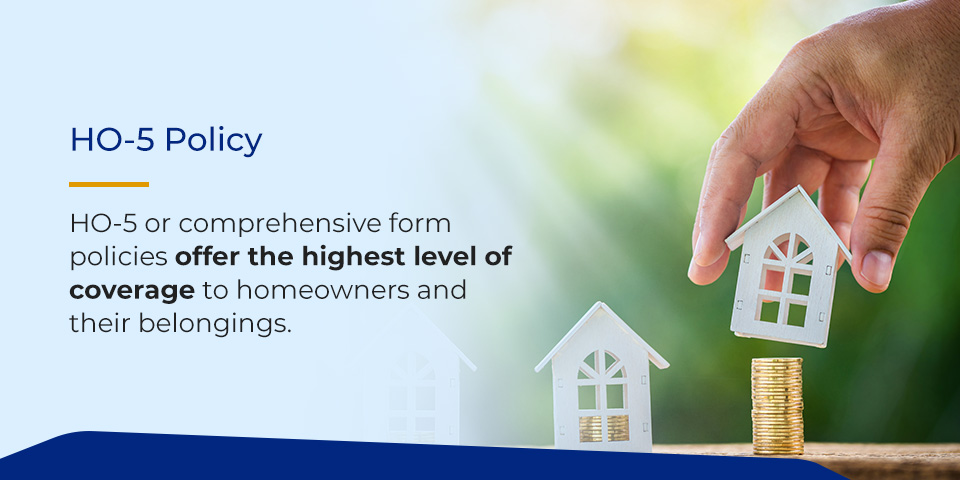Homeowners can choose from eight different types of property insurance coverage. Each is distinct in terms of what perils you’re protected against. It’s essential to learn about the options available and choose the one that best suits your needs.
This guide dives into the different types of homeowners insurance policies and answers some important questions about the benefits of such coverage and factors to consider when purchasing insurance to protect yourself and your assets.
Types of Homeowners Insurance
There are eight types of homeowners insurance policies, offering various coverage to different property types:
1. HO-1 Policy
HO-1 insurance provides the least coverage to single-family homes. It is also known as a basic form insurance, and it only covers the physical structure and personal belongings. The coverage is at the assets’ actual cash value. Actual cash value is the amount needed to replace or fix your property minus depreciation or a decrease in property value due to physical condition or age.
The policy provides coverage to 10 perils:
- Theft
- Smoke
- Explosion
- Vandalism
- Fire or lightning
- Volcanic eruption
- Windstorm or hail
- Riot or civil commotion
- Damage caused by aircraft
- Damage caused by vehicles
An HO-1 policy excludes coverage for personal liability, additional living expenses and medical payments to others. It’s generally the most affordable coverage available but rarely sold. According to a homeowners insurance report from the National Association of Insurance Commissioners (NAIC), only 1.8% of single-family homes have HO-1 policies.
2. HO-2 Policy
An HO-2 or board form homeowners insurance provides extended coverage than an HO-1 policy. It provides coverage for the following:
- Personal liability
- Medical payments to third parties
- Personal property at its actual cash value
- Loss of use or additional living expenses coverage
- The physical structure at its replacement cost value
- Unattached structures at their replacement cost value
Replacement cost value is the cost to rebuild the property or replace your belongings at the current market price without depreciation. HO-2 homeowners insurance provides six additional coverages to the 10 included under HO-1:
- Freezing
- Falling objects
- Weight of snow, ice or sleet
- Accidental discharge or overflow of water or steam
- Sudden and accidental damages caused by artificially generated electrical current
- Sudden and accidental cracking, burning or bulging of built-in appliances like centralized heating and cooling systems and water heaters
HO-2 homeowners insurance is more common than an HO-1 policy. The NAIC report shows that 6.7% of homeowners with coverage have HO-2 policies.
3. HO-3 Policy
An HO-3 or special form policy is the most common type of homeowners insurance. According to the NAIC report, 78.2% of homeowners with coverage have HO-3 policies. It provides coverage for the following:
- Personal liability
- Personal belongings
- The physical structure
- Unattached structures
- Additional living expenses
- Medical payments to others
An HO-3 policy covers the home at its replacement cost and personal belongings at their actual cash value. However, in most cases, you can add a replacement cost personal property endorsement at a fee. Typically, HO-3 insurance is a named-peril policy for personal property and an all-risks or open-peril policy for buildings, meaning it protects your home against all perils unless expressly excluded.
HO-3 policies usually pay the repair or replacement costs for the dwelling up to your limits, so long as the damage was not due to the following typical exclusions:
- Flooding
- Negligence
- Earthquake
- Power failure
- Wear and tear
- Pets and insects
- Intentional damage
- War or nuclear accidents
- Industrial pollution or smoke
- Theft in unoccupied homes or homes under construction
- Government or legal actions due to circumstances such as faulty construction, lack of permits and inadequate maintenance
For personal belongings, standard HO-3 policies provide coverage for the same 16 perils covered under HO-2 insurance.
4. HO-4 Policy
An HO-4 policy is also known as rental insurance. Most homeowners insurance includes dwelling coverage, but this type is designed for renters and only provides coverage for personal belongings. Rental insurance also includes liability coverage and additional living expenses.
The coverage applies to the 16 perils under HO-3. HO-4 insurance does not cover the rental unit itself since it’s created for renters and not homeowners — there is no dwelling coverage for the physical structure. The owner’s homeowners insurance will cover the losses if the house or apartment is damaged. HO-4 is common among tenants of homes and condominiums, with 75.4% having this coverage.
5. HO-5 Policy

HO-5 or comprehensive form policies offer the highest level of coverage to homeowners and their belongings. They also provide coverage for liability, additional living expenses and medical payments to others. It’s best suited for high-value properties that require access to protections excluded from standard policies. If you want a higher dwelling coverage limit and extra property protection, the comprehensive form is for you. HO-5 policies are open-peril for structures and belongings, covering all perils except those expressly excluded.
An HO-5 policy insures the dwelling and personal property at its replacement cost by default. However, HO-5 policies provide high coverage limits for costly assets with strict coverage limits like jewelry. This coverage generally costs more than other policies. According to the NAIC report, 13% of home insurance policies are comprehensive.
6. HO-6 Policy
HO-6 policy, also known as condo insurance or unit-owners form. As the name suggests, it’s designed for people who live in condos or co-ops. HO-6 policies cover the following:
- Personal belongings
- Floors, walls and ceilings
- Additionally living expenses
- Medical payments to others
- Renovations made after buying the condo
The coverage extends to the 16 perils listed under HO-2 and HO-3 policies. The amount you pay for dwelling coverage depends on the coverage under the condo association’s master policy, which usually covers the exterior of the condo building and common areas. In most cases, condo owners buy the coverage to cover renovation costs like kitchen remodeling and bathroom upgrades. According to NAIC, 24.6% of condo owners with insurance have HO-6 policies.
7. HO-7 Policy
An HO-7 policy is a mobile home insurance with similar features to an HO-3 policy. It’s also an open peril policy covering the following structures:
- Trailers
- Modular homes
- Sectional homes
- Single- and double-wide mobile homes
- Single- and double-wide manufactured homes
The coverage extends to:
- Personal liability
- Personal belongings
- The physical structure
- Additional living expenses
- Medical payments to others
All the 16 perils listed under HO-3 are usually included in HO-7 policies. Also, the coverage usually applies when the mobile home is stationary.
8. HO-8 Policy
HO-8 policies generally cover old homes and features that are difficult to replace. It’s ideal for situations where the property’s replacement cost exceeds the market value. The policy extends coverage to the following:
- Personal liability
- Personal belongings
- The physical structure
- Additionally living expenses
- Medical payments to others
HO-8 insurance covers the 10 named perils under HO-1. The payouts are generally at actual cash value. According to the NAIC report, only 0.4% of homeowners insurance is HO-8.
FAQs
Here are answers to some frequently asked questions:
What Are the Benefits of Homeowners Insurance?
Homeowners insurance offers many benefits, including:
- Peace of mind
- Protection for homes
- Protection of personal belongings
- Personal protection against lawsuits
What Factors Should You Consider When Choosing Homeowners Insurance?
When choosing homeowners insurance, consider the following factors to ensure you get the right coverage for your needs:
- Policy limits
- Deductibles
- Premiums costs
- The coverage type
- Reputation of the insurance company
Contact Gunn-Mowery, LLC With Your Insurance Needs
Gun-Mowery, LLC is an insurance agency that helps homeowners find the ideal insurance coverage, considering their needs. We provide quick responses and shop around to get you the best deal. Our professionals are dedicated and ready to assist. Experience the Upside of Insurance — contact us now!

